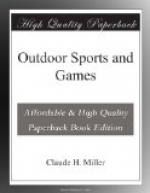The best lines for fly fishing are made of braided enamelled silk. Some fly lines are tapered but this is not necessary and is a needless expense. Twisted lines are much cheaper but very unsatisfactory.
Fly fishing is not only the most scientific and sportsmanlike method of fishing but it is also the most difficult to acquire skill in. It is of course possible to catch trout and salmon on other bait than flies. In fact, there is really no better bait for brook trout than common fish worms that have been scoured in sand. The use of a fly, however, is more satisfactory where the pleasure derived in fishing is more important than the size of the string.
[Illustration: An artificial fly; used for salmon]
In learning to cast a fly, you can practise at home, either in an open space or wherever there is room to work the line. It is not necessary to practise with the actual hooks or flies on the line. Simply tie a knot in it. Hold the rod lightly but firmly in the right hand. Point your thumb along the line of the rod and start by pulling out a little line from the reel with the left hand. With a steady sweep, cast the end of the line toward some near-by object and with each cast pull out a little more line until you reach a point when you are handling all the line you can take care of without effort or without too much of a sweep on the back cast. You must not allow the line to become entangled in trees or other obstacles. The wrist does most of the work in casting. The elbow should be close to the side. If you find that the line snaps like a whip on the back cast, it is because you start the forward cast before the line straightens out behind.
When you can handle twenty-five or thirty feet accurately, you can safely get ready to go fishing. The most successful fly fishermen use a short line, but they use it with the utmost accuracy and can make the flies land within a foot of the place they are aiming at almost every time. When a trout strikes your fly, you must snub him quickly or he will surely get away. If the flies you are using do not cause the fish to rise, and if you are certain that it is not due to your lack of skill, it will be well to change to some other combination of colours; but give your first selection a fair trial.
Bait casting is much easier than fly casting as the weight of the bait will help to carry out the line. It is the common method of fishing with minnows, frogs, small spoons and spinners, and other artificial lures. Some fishermen practise the method of allowing the line to run from the reel. The principal point in this way of fishing is to stop the reel by using the thumb as a brake at the instant that the bait strikes the water. This prevents the reel from spinning and causing the line to overrun. Neglect of this precaution will cause a very annoying tangle that is sometimes call a “backlash” but more often characterized by much harsher names by the impatient fisherman who has the misfortune to experience it.




